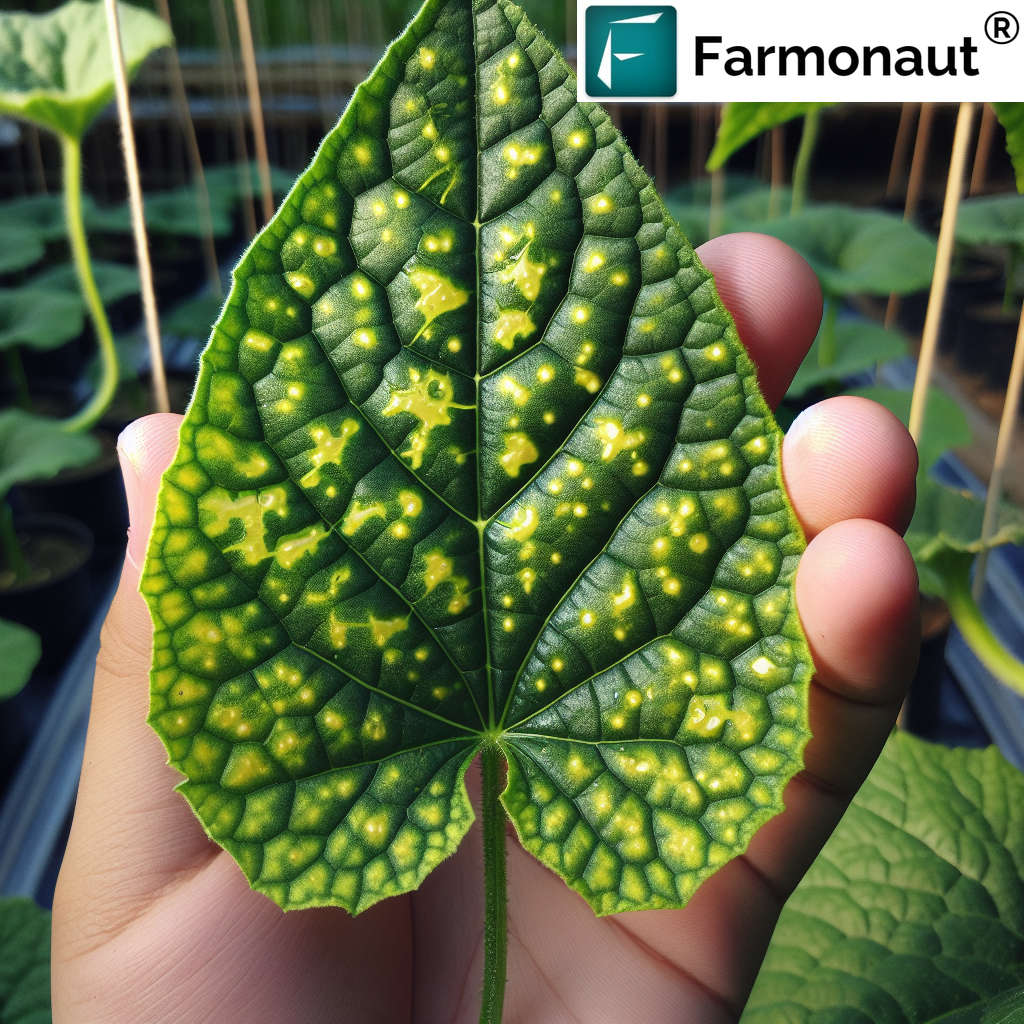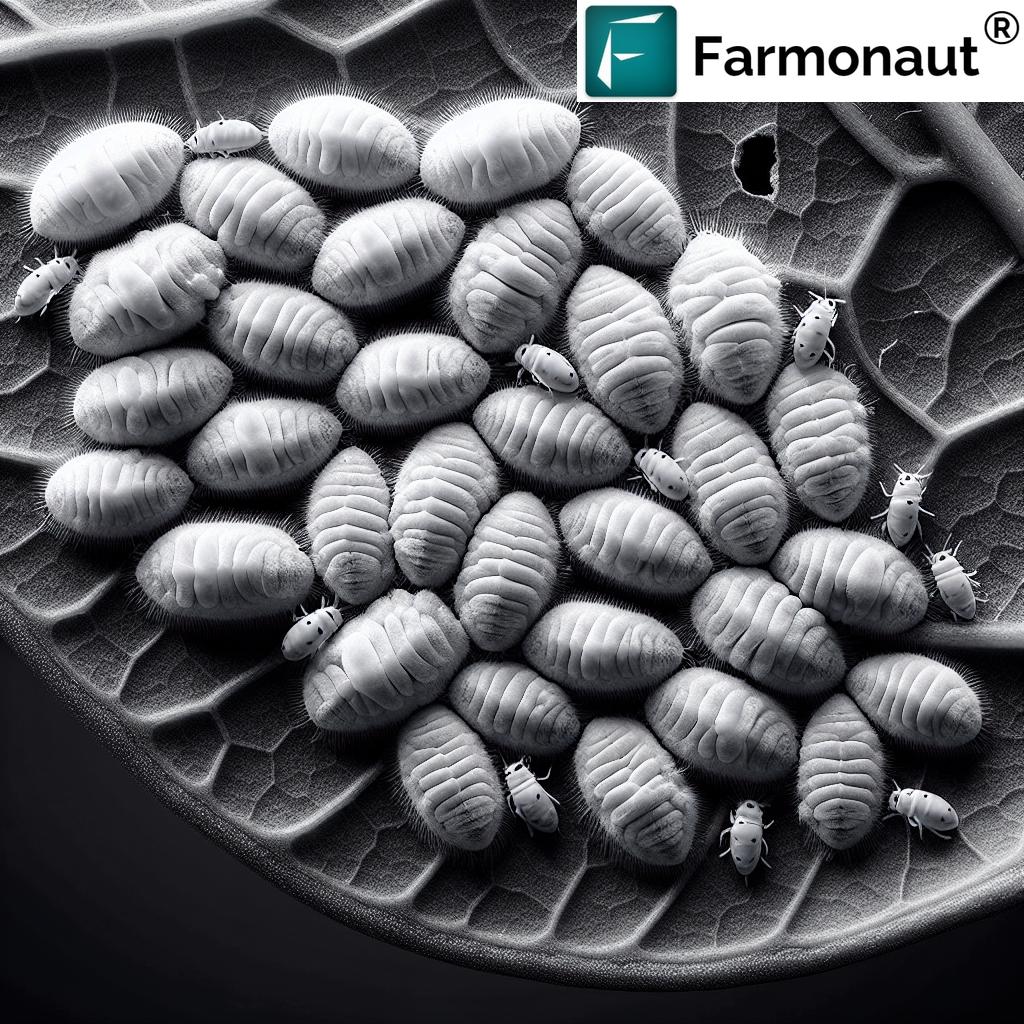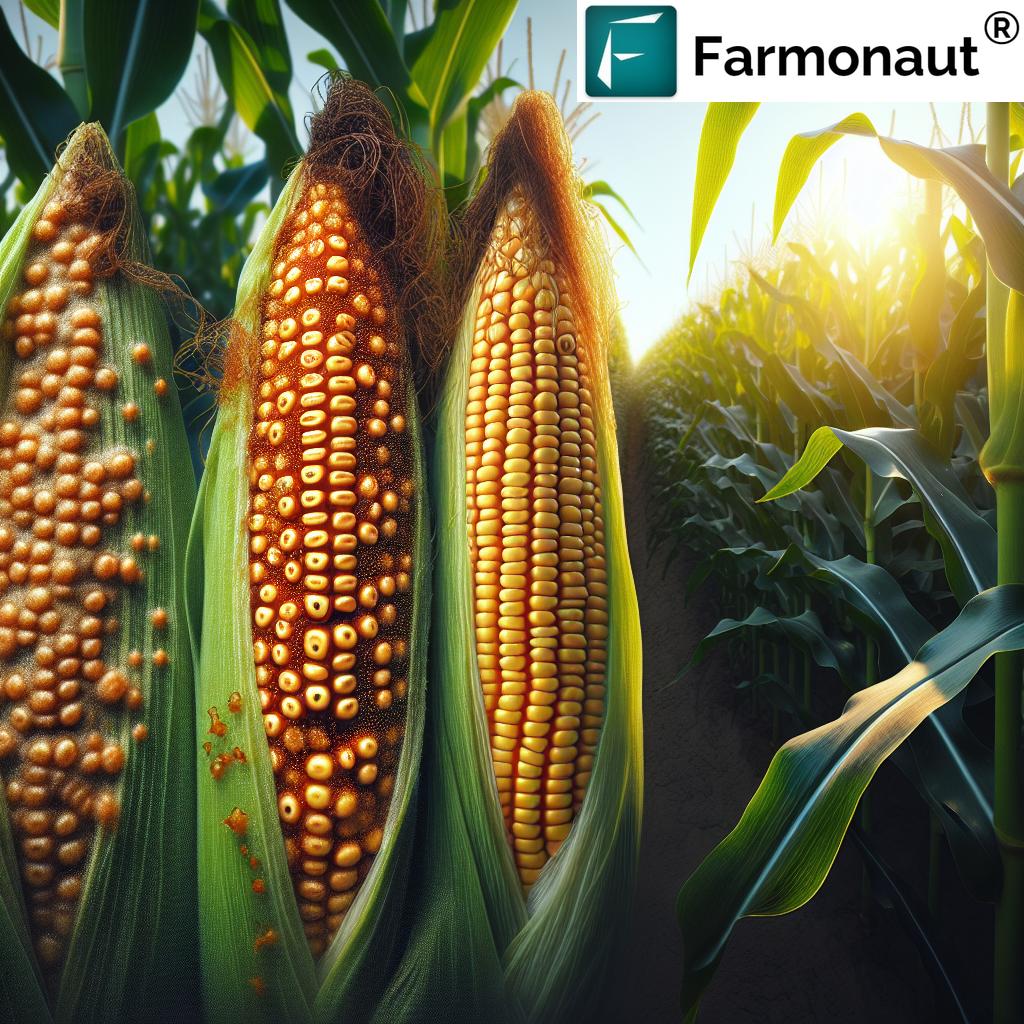Angular Leaf Spot: A Comprehensive Guide to Symptoms, Causes, and Treatments

At Farmonaut, we understand the challenges farmers face when dealing with plant diseases. One such disease that can significantly impact crop yield and quality is angular leaf spot. In this comprehensive guide, we’ll explore everything you need to know about angular leaf spot, including its symptoms, causes, and effective treatments for cucumber and strawberry plants.
What is Angular Leaf Spot?
Angular leaf spot is a bacterial disease that affects various plants, most notably cucumbers and strawberries. This disease can cause significant damage to crops, leading to reduced yields and economic losses for farmers. As experts in agricultural technology and plant health, we at Farmonaut are committed to helping farmers understand and manage this disease effectively.
Angular Leaf Spot Symptoms
Recognizing the symptoms of angular leaf spot is crucial for early detection and treatment. Here are the key angular leaf spot symptoms to look out for:
- Small, water-soaked lesions on leaves
- Lesions that become angular in shape as they are confined by leaf veins
- Lesions that turn yellow to brown and eventually dry out
- Translucent appearance of lesions when held up to light
- Leaf tissue that becomes brittle and may fall out, creating a “shot-hole” appearance
- In severe cases, lesions on fruits, stems, and petioles

What is Leaf Spot Caused By?
Understanding the cause of angular leaf spot is essential for developing effective prevention and treatment strategies. So, what is leaf spot caused by? Let’s explore the primary culprits:
Angular Leaf Spot of Cucumber Caused By
The angular leaf spot of cucumber caused by the bacterium Pseudomonas syringae pv. lachrymans. This pathogen thrives in warm, humid conditions and can spread rapidly through a crop, especially during wet weather.
Angular Leaf Spot Strawberry
In the case of strawberries, angular leaf spot strawberry is caused by the bacterium Xanthomonas fragariae. This pathogen is particularly problematic in strawberry production areas with cool, wet conditions.
How Angular Leaf Spot Spreads
Angular leaf spot can spread through various means, including:
- Splashing water from rain or irrigation
- Contaminated tools and equipment
- Infected plant debris
- Wind-blown rain
- Human activity in the field
At Farmonaut, we use advanced satellite imagery and AI technology to monitor crop health and detect early signs of disease spread. Our platform can help farmers identify potential outbreaks before they become severe, allowing for timely intervention.
Angular Leaf Spot Treatment
Effective angular leaf spot treatment involves a combination of cultural practices, chemical controls, and preventive measures. Here’s a comprehensive approach to managing this disease:
Cultural Practices
- Crop rotation: Avoid planting susceptible crops in the same field for at least 2-3 years.
- Proper spacing: Ensure adequate plant spacing to improve air circulation and reduce humidity.
- Sanitation: Remove and destroy infected plant debris after harvest.
- Irrigation management: Use drip irrigation or water at the base of plants to avoid wetting foliage.
- Resistant varieties: Plant resistant cultivars when available.
Chemical Controls
When cultural practices are insufficient, chemical controls may be necessary. Here are some options for angular leaf spot cucumber treatment and strawberry treatment:
- Copper-based fungicides
- Streptomycin (for strawberries, where permitted)
- Bacillus subtilis-based biological fungicides
Always follow label instructions and local regulations when applying any chemical treatments.
How to Treat Angular Leaf Spot Using Farmonaut’s Technology
At Farmonaut, we believe in the power of precision agriculture to combat plant diseases effectively. Here’s how to treat angular leaf spot using our advanced technology:
- Early detection: Our satellite-based crop health monitoring system can detect changes in plant health before visible symptoms appear. This allows for early intervention and targeted treatment.
- Precision application: By identifying specific areas of infection, our technology enables farmers to apply treatments only where needed, reducing chemical use and costs.
- Data-driven decision making: Our AI-powered advisory system, Jeevn AI, provides personalized recommendations for treatment based on real-time crop health data, weather forecasts, and historical patterns.
- Continuous monitoring: After treatment, our system continues to monitor crop health, allowing farmers to assess the effectiveness of their interventions and make adjustments as needed.
To learn more about how Farmonaut can help you manage angular leaf spot and other crop health issues, visit our app or explore our API services.
Prevention Strategies
Preventing angular leaf spot is often more effective than treating it. Here are some key prevention strategies:
- Use disease-free seeds and transplants
- Implement proper sanitation practices in the field and greenhouse
- Avoid overhead irrigation when possible
- Control weeds that may serve as alternate hosts
- Monitor weather conditions and apply protective fungicides before periods of high disease risk
- Use Farmonaut’s weather forecasting and crop monitoring tools to anticipate and prepare for high-risk periods
The Impact of Climate on Angular Leaf Spot
Climate plays a crucial role in the development and spread of angular leaf spot. Understanding these factors can help farmers better manage the disease:
- Temperature: The disease thrives in temperatures between 75-82°F (24-28°C)
- Humidity: High humidity (above 80%) favors disease development
- Rainfall: Frequent rain or overhead irrigation increases disease spread
- Wind: Can aid in the dispersal of bacteria over short distances
Farmonaut’s advanced weather forecasting capabilities can help farmers anticipate these conditions and take preventive measures accordingly. Our system provides detailed, localized weather data that can be invaluable in disease management strategies.
Economic Impact of Angular Leaf Spot
Angular leaf spot can have significant economic consequences for farmers. The disease can lead to:
- Reduced crop yields
- Lower quality produce, which may be unmarketable
- Increased production costs due to the need for fungicides and other treatments
- Potential loss of entire crops in severe cases
By implementing effective management strategies and utilizing advanced technologies like those offered by Farmonaut, farmers can minimize these economic impacts and protect their livelihoods.
The Role of Integrated Pest Management (IPM) in Controlling Angular Leaf Spot
Integrated Pest Management (IPM) is a holistic approach to pest and disease control that combines various strategies to minimize economic, health, and environmental risks. When it comes to managing angular leaf spot, IPM can be particularly effective. Here’s how IPM principles can be applied:
- Monitoring: Regularly inspect crops for signs of disease. Farmonaut’s satellite-based monitoring system can provide early detection of potential issues.
- Prevention: Implement cultural practices that create an environment less favorable to disease development.
- Thresholds: Establish action thresholds based on disease pressure and economic factors to determine when intervention is necessary.
- Control methods: Use a combination of biological, cultural, mechanical, and chemical controls as needed.
- Evaluation: Continuously assess the effectiveness of management strategies and adjust as necessary.
By adopting an IPM approach, farmers can more effectively manage angular leaf spot while minimizing reliance on chemical controls and reducing overall costs.
The Future of Angular Leaf Spot Management
As agricultural technology continues to advance, new methods for managing angular leaf spot are emerging. At Farmonaut, we’re at the forefront of these developments:
- Gene editing: Research into CRISPR technology may lead to the development of more resistant plant varieties.
- Biocontrol agents: New biological control methods using beneficial microorganisms are showing promise in disease suppression.
- Nanotechnology: Nanoparticle-based treatments may offer more targeted and efficient disease control.
- AI and machine learning: Advanced algorithms can predict disease outbreaks with increasing accuracy, allowing for proactive management.
Our team at Farmonaut is continuously exploring these new technologies to provide farmers with the most advanced and effective tools for crop management.
How Farmonaut’s Satellite System Compares to Drone and IoT-Based Farm Monitoring
| Feature | Farmonaut Satellite System | Drone-based Monitoring | IoT-based Monitoring |
|---|---|---|---|
| Coverage Area | Large scale (hundreds to thousands of acres) | Limited by flight time and regulations | Limited by sensor placement |
| Frequency of Data Collection | Daily to weekly, depending on satellite pass | As needed, but requires manual operation | Continuous, real-time data |
| Initial Setup Cost | Low (subscription-based) | High (equipment purchase and training) | Moderate to high (sensor network installation) |
| Operational Complexity | Low (automated data collection and analysis) | High (requires skilled operators) | Moderate (requires maintenance of sensor network) |
| Weather Dependency | Low (can penetrate cloud cover) | High (limited by wind and precipitation) | Low (operates in most weather conditions) |
| Data Analysis Capabilities | Advanced (AI-powered insights) | Moderate (requires separate analysis tools) | Varies (depends on integrated software) |
| Scalability | Highly scalable (global coverage) | Limited by equipment and manpower | Moderate (requires additional sensors for expansion) |
As you can see, Farmonaut’s satellite-based system offers significant advantages in terms of coverage, cost-effectiveness, and scalability, making it an ideal choice for farmers looking to implement precision agriculture techniques on a large scale.
FAQs About Angular Leaf Spot
Here are some frequently asked questions about angular leaf spot:
- Q: Can angular leaf spot affect other crops besides cucumbers and strawberries?
A: Yes, angular leaf spot can affect various plants, including other cucurbits like melons and squash, as well as some ornamental plants. - Q: How long can the bacteria survive in the soil?
A: The bacteria causing angular leaf spot can survive in crop debris for several months, which is why proper sanitation and crop rotation are important. - Q: Are there any natural remedies for angular leaf spot?
A: While not as effective as chemical treatments, some natural remedies like neem oil or garlic spray may help suppress the disease. However, these should be used in conjunction with other management practices. - Q: How often should I apply fungicides to prevent angular leaf spot?
A: The frequency of fungicide applications depends on various factors, including weather conditions and disease pressure. Farmonaut’s AI advisory system can provide personalized recommendations based on your specific situation. - Q: Can angular leaf spot be transmitted through seeds?
A: Yes, the bacteria can be seed-borne. It’s important to use certified disease-free seeds or treat seeds before planting.
Conclusion
Angular leaf spot is a challenging disease that requires vigilant management and a multi-faceted approach. By understanding its symptoms, causes, and treatment options, farmers can effectively protect their crops and maintain high yields. At Farmonaut, we’re committed to providing cutting-edge technology and expert advice to help farmers combat angular leaf spot and other crop health issues.
Our satellite-based monitoring system, AI-powered advisory tools, and comprehensive data analysis capabilities offer unparalleled support for precision agriculture. By leveraging these advanced technologies, farmers can detect and respond to angular leaf spot outbreaks more quickly and effectively than ever before.
To experience the benefits of Farmonaut’s innovative agricultural solutions, download our app for Android or iOS, or explore our API documentation for custom integrations.
Together, we can revolutionize crop management and ensure healthier, more productive farms for the future.












